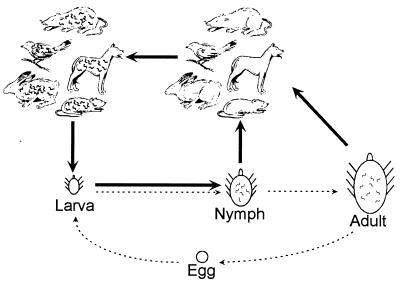FIG. 4.
Diagram of the life cycles of B. burgdorferi and Ixodes sp. vector ticks. Tick larvae hatch and feed once; then they molt into nymphs, which also feed once, and then into adults, which mate, feed once, lay eggs, and then die (dashed arrows). Larvae acquire B. burgdorferi by feeding on infected hosts and then transmit the bacteria to new hosts during feeding in the nymph and adult stages (solid arrows). The tick hosts include a large variety of species of mammals, birds, and reptiles, many of which are susceptible to B. burgdorferi infection and serve as reservoir animals. In many geographic areas, adult Ixodes sp. ticks do not feed on the same animal hosts as the larvae or nymphs and so do not contribute greatly to the maintenance of B. burgdorferi in these locations (35, 67).

